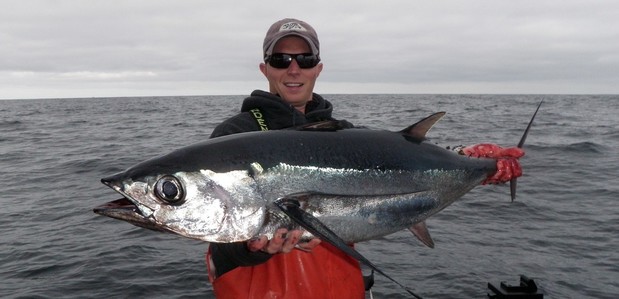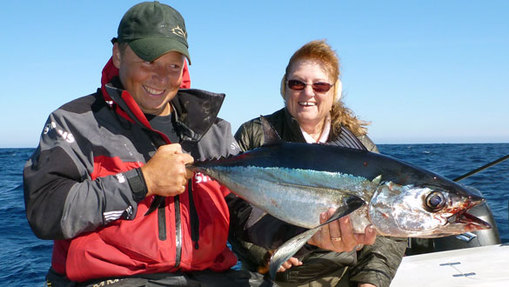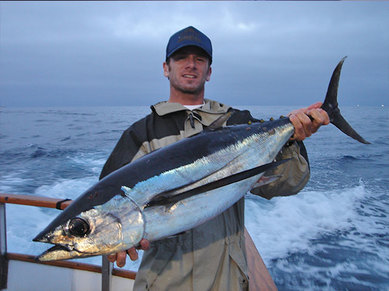Albacore Tuna
Description: The body of the albacore tapers at both ends (cigar-shaped). The head is long and the mouth fairly large. The color is dark gray to metallic blue on the back becoming white to gray below. Albacore are easily distinguished from the other tunas occurring off California, with exception of the bigeye, by the extreme length of their pectoral fins (they extend well past the anal fin). Albacore and bigeye can best be distinguished by the characteristics of their livers. The albacore has a heavily striated (covered with blood vessels) liver while the liver of the bigeye is only lightly striated along the edges.
Range: Albacore occur worldwide in temperate seas; in the eastern Pacific they range from south of Guadalupe Island, Baja California, to southeast Alaska.
Range: Albacore occur worldwide in temperate seas; in the eastern Pacific they range from south of Guadalupe Island, Baja California, to southeast Alaska.

Natural History: The food of the albacore varies, depending upon where they are feeding in the water column and what items are available at the time and place the albacore are feeding. A majority of the food consists of small fishes, but at times squid, octopus, shrimp-like and crab-like organisms are extremely important. There are indications that albacore spawning takes place in the mid-Pacific, probably north and west of the Hawaiian Islands. Large specimens caught in that area during late summer on long line gear have had nearly ripe eggs in their ovaries. The albacore is one of the world's fastest migrant fish. Annual trans-Pacific migrations have been documented by tagging. Fish tagged off California were captured off Japan, nearly 5,000 miles away, 294 days later. Traveling "as the crow flies", this is equivalent to more than 17 miles a day.

Fishing Information: Albacore are the most sought after of the tunas by California anglers. Most fishing for albacore takes place 20-100 miles offshore in central and southern California. They are rarely taken near shore. Albacore have a preference for deep blue oceanic water and mild temperatures. Studies indicate that 57 of every 100 albacore caught are hooked in water ranging in temperature between 60° and 64° F. Albacore travel in loosely knit schools which are located by trolling or observing surface signs (feeding birds, etc.). Once located, they are fished with hook and line using live anchovies for bait. They may also be caught on a trolled feathered jig.
Other Common Names: longfin, albie, pigfish, Pacific albacore, German.
Other Common Names: longfin, albie, pigfish, Pacific albacore, German.

